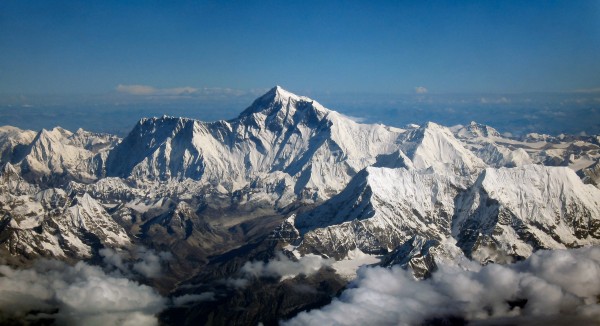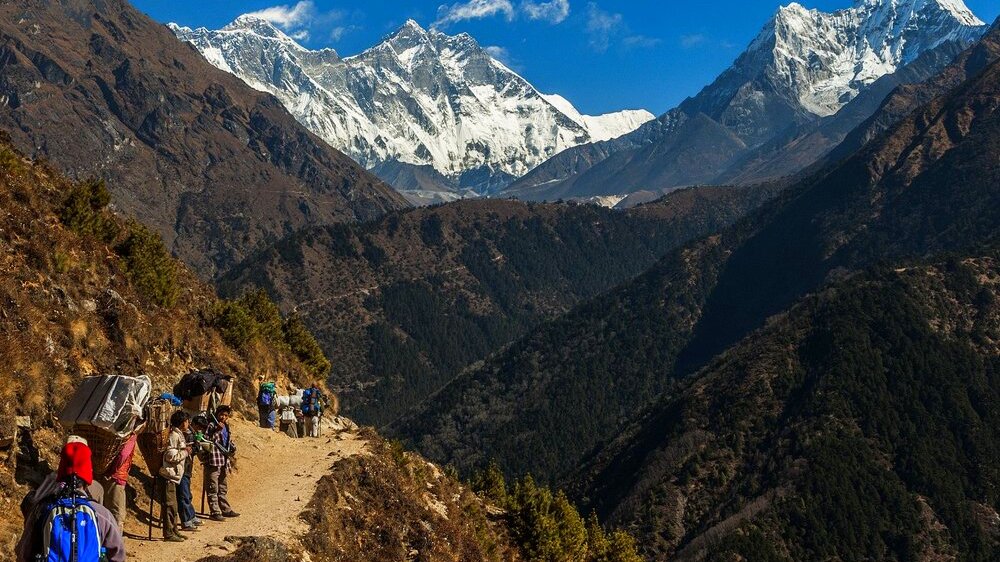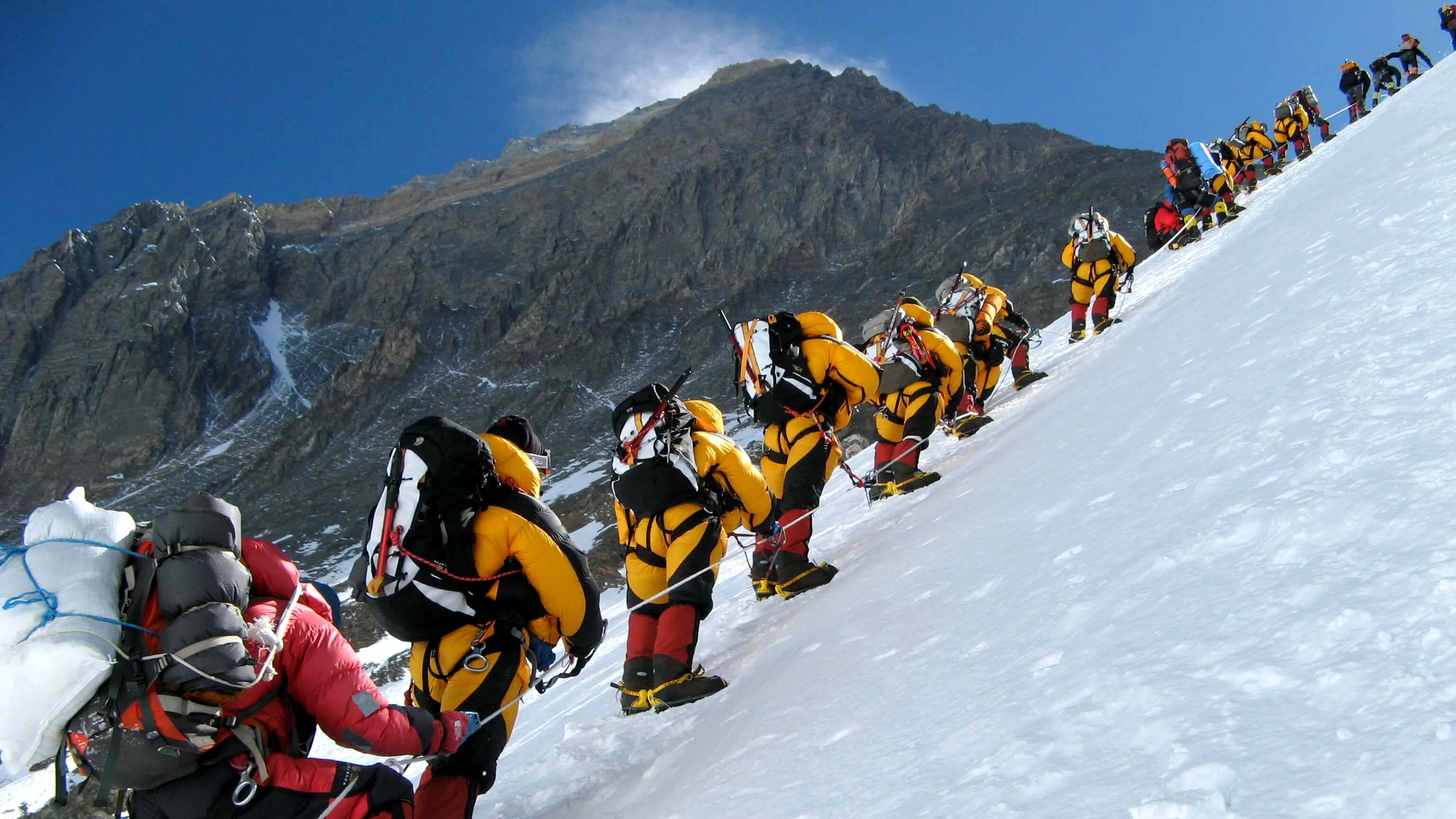15 Interesting Facts about Mount Everest
Mount Everest, with its staggering height of 8,848.86 m (29,032 ft), stands as the world's unparalleled tallest mountain. Nestled within the vastness of the Himalayan range, this majestic peak finds its roots in the Solu-Khumbu region of Nepal, extending its grandeur to the Tibetan territory in the north, an integral part of China.
Dotted around its foothills, there are two primary embarkation points or base camps for climbers and adventurers. The South Base Camp, proudly positioned in Nepal, elevates itself at 5,364 meters (17,598 ft). In contrast, its counterpart, the North Base Camp in Tibet, lies at an altitude of 5,150 meters (16,900 ft). These camps serve as the springboards for those with eyes set on Everest’s summit.

Delving deeper into their specifics, the South Base Camp in Nepal sees a higher footfall. Nepal’s rich mountaineering legacy coupled with its well-developed trekking infrastructure has cemented its popularity. Trekkers to this base camp are treated to a visual feast - spanning panoramic views of the sprawling Himalayas, the intricate tapestry of Sherpa villages, and the biodiversity wonderland that is Sagarmatha National Park.
The North Base Camp in Tibet, though equally mesmerizing, comes with its set of administrative intricacies. A journey here mandates a special permit from the Chinese government, in addition to the standard permit to enter Tibet. Such layers of bureaucratic requirements often deter the average traveler, granting the South Base Camp an edge in terms of popularity.
When embarking on such a Himalayan adventure, remember that the choice of base camp isn’t just about accessibility. Each offers its unique blend of experiences, perspectives, and challenges. And for those seeking the best guidance, Luxury Holidays Nepal promises unparalleled expertise every step of the way.
Interesting Facts about Mount Everest
The Naming Mystery
Mount Everest, christened in honor of Sir George Everest, the British surveyor-general of India, resonates differently in the diverse cultural tapestries that surround it. In the heart of Nepal, it is revered as Sagarmatha, translating to "Goddess of the Sky." Meanwhile, in the Tibetan highlands, it is fondly known as Chomolungma, signifying both "Goddess Mother of the World" and "Goddess of the Earth."

These distinct epithets do more than just identify a mountain; they encapsulate the profound spiritual and cultural sentiments of the regions. Both Sagarmatha and Chomolungma exemplify the deep-rooted awe and sacred aura that Mount Everest holds, underscoring its magnificent stature not just in the physical realm, but also in the spiritual hearts of the communities that revere it. The names symbolize the mountain's harmonious interplay with nature, casting it as an enduring emblem of beauty and fortitude. With Luxury Holidays Nepal, explore this majestic peak and its rich cultural tapestry.
Mount Everest is about 60 million years old
Situated amidst the vast Himalayan expanse, Mount Everest boasts a fascinating geological tapestry that dates back millions of years. The grandeur of the Himalayas, with Everest as one of its crowning jewels, has its origins approximately 60 million years ago. This was when the mighty Indian subcontinent, in a monumental tectonic move, collided with the Eurasian plate.
This colossal convergence gave rise to a dramatic uplift of sediments, paving the way for the creation of the iconic Himalayan mountain ranges. With the passage of time, myriad forces—tectonic shifts, relentless erosion, and the relentless rhythms of weathering—have intricately carved and molded Mount Everest into the breathtaking marvel we witness today.
Although pinning down the exact age of Mount Everest is a daunting endeavor, a synthesis of geological markers and scientific explorations lends credence to its majestic presence for around 60 million years. Dive deeper into this geological marvel with the insights and expertise of Luxury Holidays Nepal.
Mount Everest Rises 40 cm Per Century
Delving into the annals of scientific research and comprehensive geological examinations, it's captivating to discover that Mount Everest is not static. It is ascending at an estimated pace of about 4 millimeters each year, culminating in a growth of 40 centimeters every century. This remarkable elevation surge stems from the enduring tectonic dance between the Indian and Eurasian plates. Their continuous collision fosters the gradual uplift of the iconic Himalayas.
As we journey through the vast corridors of geology, it's pivotal to recognize that these measurements echo the nuances of long-standing geological narratives. These rates might exhibit variations, contingent upon specific temporal phases or distinct geographical locales. Embark on a deeper exploration of this geological wonder with Luxury Holidays Nepal.
Triumph of the Human Spirit
On the monumental date of May 29, 1953, two intrepid souls, Sir Edmund Hillary from New Zealand and the valiant Sherpa Tenzing Norgay from Nepal, immortalized their legacy atop Mount Everest. Their ascent wasn't just a climb; it was a testament to human resilience, unyielding determination, and the essence of collaboration.
Their pioneering endeavor ignited the imaginations of countless adventurers worldwide. More than just a mountaineering feat, their journey encapsulated the boundless human spirit's capacity to chase dreams and transcend formidable barriers. The footprints Hillary and Norgay left on the Everest summit heralded a new epoch in mountain exploration. Their timeless story, curated by Luxury Holidays Nepal, serves as a beacon, underscoring that with grit and tenacity, no peak is too high to scale.
The Death Zone Is Above 8,000 Meters and the Death rate at Mount Everest
At an altitude surpassing 8,000 meters (26,000 feet), the formidable realms of high-altitude mountains like Mount Everest harbor the ominously named "death zone". The title doesn't exaggerate; this elevation sees the human body struggling to acclimatize due to critically reduced oxygen, causing a gradual, perilous decline. With the atmospheric pressure being roughly a third of what one would find at sea level, oxygen becomes a scarce, precious commodity.
 climbing-0.jpg)
Beyond the oxygen scarcity, the death zone of Everest presents an arsenal of challenges. From the biting cold, volatile weather shifts, to the looming threat of avalanches, every step is a dance with danger. Even armed with bottled oxygen, state-of-the-art gear, and fortified attire, climbers find their physical and mental prowess waning significantly in this treacherous zone.
Mount Everest's mortality rate isn't static; it oscillates with each passing year. Since the 1990s, we've observed an average death rate hovering between 4-5%. It's paramount for climbers to comprehend the magnitude of risks this embodies. Mastery in mountaineering, rigorous physical training, and astute judgment become non-negotiable assets. The magnetic pull of Everest's splendor draws adventurers globally, but it's essential to approach with reverence, recognizing the mighty mountain's challenges and nature's unyielding forces. Dive deeper into the intricacies of Everest with Luxury Holidays Nepal.
The First Tweets and First Phone-call From the Summits
In the icy expanses of Mount Everest, where nature's grandeur meets human tenacity, technology has etched some remarkable milestones. On May 21, 2007, the world witnessed a fusion of adventure and innovation when British mountaineer Rod Baber placed the first-ever mobile phone call from the mountain's summit, a feat orchestrated through a collaboration with Motorola.
Fast forward a few years, and another digital frontier was crossed. On May 6, 2011, Kenton Cool, a British mountaineer, bridged the realms of mountaineering and social media by sending out the inaugural tweet from Everest's pinnacle. This technological marvel was facilitated by a 3G connection established by Ncell, an arm of TeliaSonera.
These achievements, curated by Luxury Holidays Nepal, not only highlight human perseverance but also accentuate the boundless reach of modern technology, proving that it can touch even the loftiest heights and most isolated corners of our planet.
Sherpas: The Unsung Heroes
At the intersection of the towering peaks of Mount Everest and the indomitable spirit of adventure, lie the Sherpas - the true backbone of Himalayan expeditions. Sherpas bring unmatched mountaineering prowess and a deep-rooted familiarity with the Everest terrain to every ascent.
They do more than just support; they lead. Sherpas pave paths, ferry essential equipment, and offer both their wisdom and strength to climbers. With their adept hands setting ropes, anchoring points, and bearing significant burdens, they craft a safer passage for adventurers. Their seasoned eyes evaluate the mountain's moods, forecasting conditions, and pre-empting risks.
Beyond their technical expertise, Sherpas are the soulful compasses of the journey, guiding climbers not just through the mountain's challenging facets but also through its rich cultural tapestry. Their commitment runs deep, transforming the dream of scaling Everest from an ambition to a reality. Join Luxury Holidays Nepal in celebrating the unparalleled dedication of these mountain guardians.
History-Making Achievements
Mount Everest, an emblem of nature's grandeur, has been the canvas for myriad historic triumphs. 1953 was a watershed year, witnessing the audacious ascent by Edmund Hillary from New Zealand and the gallant Sherpa Tenzing Norgay from Nepal. Their victorious summit showcased humanity's relentless quest for exploration, igniting aspirations in countless souls.
The Hillary legacy was further enshrined when, in 1990, Peter Hillary, Sir Edmund's progeny, conquered the peak. This ascent crowned them as the premier father-son pair to vanquish Everest, a testament to the enduring flame of ambition that spans generations.
Yet, 1990 was to see another groundbreaking achievement. The Australian mountaineer, Tim Macartney-Snape, embarked on an unparalleled journey, ascending from the very embrace of the sea to Everest's zenith, all without the aid of supplemental oxygen.
These momentous expeditions, brought to you by Luxury Holidays Nepal, stand as pillars in Everest's chronicle, invigorating adventurers worldwide to redefine their own thresholds of possibility.
There are also a few more worth mentioning:
- Reinhold Messner: In 1978, the Italian mountaineer became the first person to reach the summit of Everest without the use of supplemental oxygen. Then in 1980, he became the first person to solo ascend Everest, again without supplemental oxygen.
- Apa Sherpa and Phurba Tashi: These Nepalese Sherpa climbers hold the record for the most ascents of Everest, with each having reached the summit 21 times.
- Kami Rita Sherpa: Kami Rita Sherpa had climbed Everest a record-breaking 25 times, achieving his most recent summit in 2021.
- Yuichiro Miura: This Japanese mountaineer holds the record for the oldest person to reach the summit. He achieved this feat in 2013 at the age of 80.
- Babu Chiri Sherpa: A Nepalese Sherpa who spent 21 hours on the summit of Everest in 1999, a record for the most extended stay at the top.
- Fastest ascent: The fastest ascent from the south side (Nepal) is held by Pemba Dorje Sherpa, who in 2004 made the climb from Base Camp to the summit in 8 hours 10 minutes. On the north side (Tibet), the fastest ascent is held by Italian Hans Kammerlander, who in 1996 made the climb in 16 hours 45 minutes.
These are just a few of the many remarkable achievements associated with Mount Everest. Each year, climbers from around the world attempt to add their names to this list of records.
Climbing Season
Every year, a brief stretch between April and May emerges as the coveted climbing season for Mount Everest. It's during these months that the mountain unveils its friendliest demeanor. The skies maintain their composure, temperatures cozy up, and winds dial down their fury. As snow and ice grudgingly recede, they unlock previously barricaded sections of the ascent route, and the looming threat of avalanches retreats to the backdrop.

Yet, timing is of the essence. As climbers seek that perfect summit window, they keenly monitor weather forecasts and lean on seasoned experts for guidance. This popular window, however, casts a double-edged sword. With many mountaineers sharing the same ambition, the ascent routes witness a bustling congestion. Navigating through this throng becomes its own challenge.
The mantra for success during these times? Acclimatization, to ensure one's body adjusts to the towering altitudes, and cohesive teamwork, safeguarding everyone's safety and triumph. Dive into the nuances of Everest climbing with Luxury Holidays Nepal.
Traffic Jams on Mount Everest
In recent years, Mount Everest has witnessed an unintended spectacle – traffic jams at lofty heights. The surge in summit enthusiasts has led to crowded paths, creating an unexpected hurdle in climbers' odysseys. With long queues snaking up its slopes, climbers face unwarranted delays, intensifying concerns over their safety and welfare.

The confluence of limited favorable weather windows and the dependency on fixed ropes exacerbates the congestion. While the allure of Everest's peak remains undiminished, there's an urgent need for mindful mountaineering.
Steps are afoot to mitigate this challenge. Stricter regulations are being laid out, and a clarion call for responsible climbing resonates. Ensuring smoother routes isn't just about preserving the climber's journey but also safeguarding the pristine sanctity of Everest's environment. Join Luxury Holidays Nepal in championing conscientious climbs.
Sagarmatha National Park
Nestled in the majestic Himalayas of eastern Nepal, Sagarmatha National Park stands as a testament to nature's splendor. Inaugurated in 1976 and crowned as a UNESCO World Heritage site, this expansive park stretches over 1,148 square kilometers, showcasing a breathtaking altitude variation from 2,845 meters up to the dizzying heights of Mount Everest at 8,848.86 meters.
Beyond its towering peaks, the park is a sanctuary for a myriad of distinct flora and fauna, cradling the very spirit of biodiversity. It's also the homeland of the renowned Sherpa community, celebrated for its unparalleled mountaineering prowess.
Visitors are treated to a mosaic of natural wonders, from shimmering glaciers and deep-cut gorges to the serenity of alpine woodlands. While tourism thrives as its mainstay, measures are enforced to ensure this Himalayan gem remains untarnished by the footsteps of exploration.
Each year, a multitude of travelers are lured by Sagarmatha's allure, captivated by its harmonious blend of pristine landscapes and vibrant cultural narratives. Embark on this Himalayan odyssey with Luxury Holidays Nepal.
Mount Everest might not be the tallest mountain in the World
Mount Everest often commands global attention as the world's highest peak, towering majestically above sea level. However, when it comes to deciphering the "tallest" mountain, the criteria for measurement introduce other competitors to the equation.
Consider Mauna Kea in Hawaii. While it may not rival Everest's sky-touching elevation above sea level, if you take into account its submerged base, measuring from its starting point on the ocean floor to its summit, Mauna Kea arguably surpasses Everest in sheer height.
Thus, the crown for the "tallest" mountain oscillates based on the yardstick used. Whether gauging from base to peak or focusing solely on elevation above sea level, each method brings forth its own champion. Dive deeper into these fascinating geographical insights with Luxury Holidays Nepal.
Tons of human poop are frozen on Mount Everest.
Mount Everest, while renowned as the pinnacle of mountaineering aspirations, is facing an escalating environmental issue: the accumulation of frozen human waste. With throngs of adventurers flocking to the peak each year, the lack of efficient waste management has led to a troubling build-up.
Preserved by the icy temperatures, this waste not only tarnishes the mountain's pristine beauty but also threatens its delicate ecosystem and vital water sources. Though initiatives have been launched to address this growing concern, Everest's remote locale and formidable terrains make streamlined waste management a complex endeavor.
There's an urgent call for innovative, sustainable solutions to ensure the legacy of Mount Everest remains untarnished and its ecosystem undisturbed. Dive into the conservation efforts and challenges faced by this iconic peak with Luxury Holidays Nepal.
Routes to Climb Mount Everest
The journey to the peak of Mount Everest offers climbers a myriad of pathways, each with its own set of challenges and allure. While quantifying the exact number of routes can be subjective based on varying definitions, one cannot deny the extensive choices available.
Two particularly prominent paths are the Northeast Ridge Standard Route and the South Col Route. Revered by mountaineers for their historical significance and tried-and-true nature, these routes have paved the way for numerous victorious summits. Every climb, regardless of the chosen route, demands meticulous preparation, adept experience, and a profound understanding of Everest's complexities.
Embarking on this monumental endeavor calls for more than just physical strength; it requires a mastery of the mountain's intricacies. Explore the intricacies of Everest's ascent routes with Luxury Holidays Nepal.
Beyond Adventure: Boosting the Local Economy
The iconic silhouette of Mount Everest not only stands as the world's highest peak but also as a cornerstone for the economic sustenance of Nepal's Khumbu region. The influx of adventurers and tourists translates to a myriad of employment prospects, bolstering the local economy. From guiding adventurers to catering to their needs, from infrastructure enhancement to the showcasing of local crafts, the region thrives on Everest-driven tourism.
Beyond the adventure, Everest also shines a spotlight on the rich cultural tapestry of the area, providing a boost to cultural tourism. This intersection of culture and nature translates to opportunities for artisans, storytellers, and cultural guides. As Everest continues to bring economic vitality, it also underscores the importance of sustainable tourism, striking a harmonious balance between growth and the preservation of its majestic surroundings.
Please, click here for the Everest Region Trekking.
The Complete Guide For Everest Base Camp Trek: Click Here
If you need any further information, please contact us by email: [email protected], Phone: +977- 985 100 5129 (WhatsApp)
#Tags
Tripadvisor
5.0910 reviewsGoogle
4.8110 reviewsFacebook
4.1 recommend44 ReviewsTrustpilot
4.1 Great(5 reviews)- Trusted by50K plus traveller




